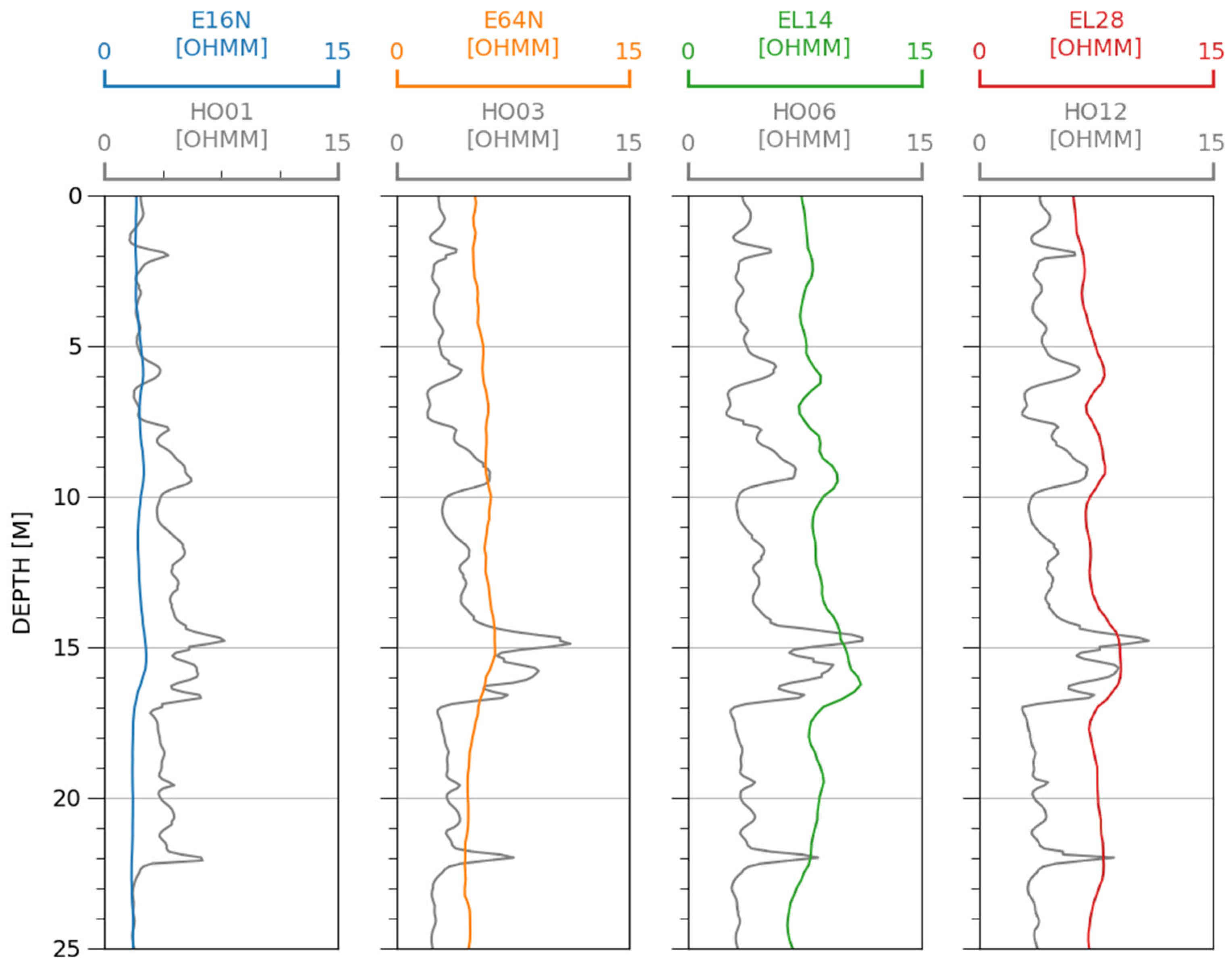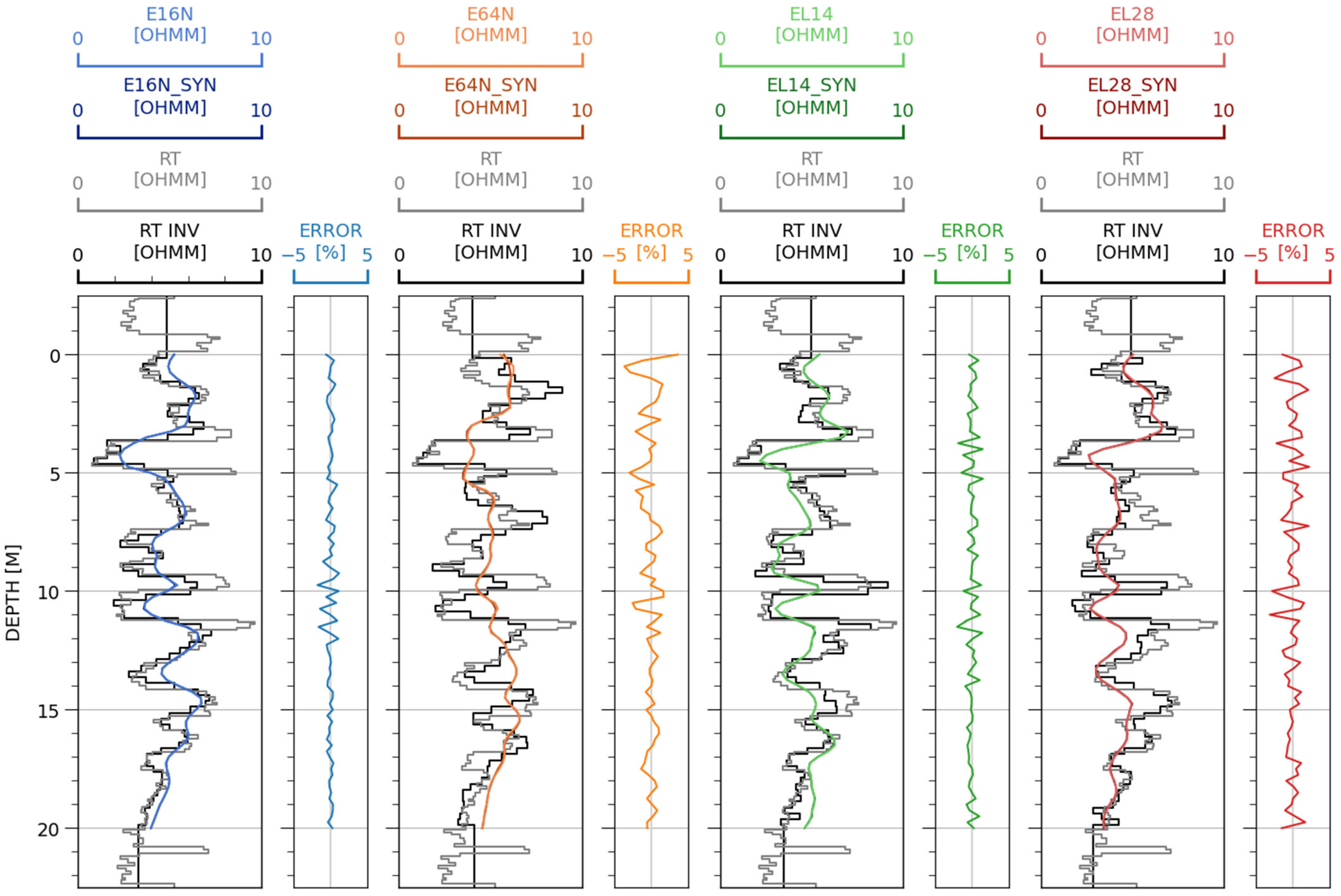Iterative Inversion of Normal and Lateral Resistivity Logs in Thin-Bedded Rock Formations of the Polish Carpathians
Abstract
1. Introduction
2. Materials and Methods
2.1. Normal and Lateral Resistivity Logs
2.2. Inversion Procedure
2.2.1. Iterative Inversion
2.2.2. Formation Model
2.2.3. Forward Modeling
2.2.4. Optimization Procedure
2.2.5. Inversion Workflow
- Initialization:A swarm of particles is generated. Each particle represents a candidate resistivity model composed of resistivity values assigned to a fixed sequence of layers in the formation. These initial models are generated by randomly sampling resistivity values within predefined bounds, ensuring a diverse and representative starting point for the search.
- Forward Modeling:For each particle, a synthetic resistivity log is computed using a finite element method based on the formation model represented by that particle.
- Objective Function Evaluation:The synthetic logs generated for each particle are compared against the input resistivity data, and a misfit is computed using the root mean square error (RMSE) across all measurement points, quantifying the discrepancy between the synthetic and observed logs.
- Parameter Update:The swarm is updated by adjusting each particle’s velocity and position. These updates are based on the particle’s own best-known solution and the global best solution found so far by the swarm according to SPSO dynamics involving inertia, cognitive, and social components.
- Convergence Check:Steps 2 through 4 are repeated iteratively until a stopping criterion is met: either a predefined number of iterations is completed or the objective function reaches a predefined minimum threshold.
2.3. Factors Affecting the Results of the Inversion Procedure
2.3.1. Incorrect Mud Resistivity
2.3.2. Misalignments in Measurement Depths
2.3.3. Boundary Effects
2.3.4. Assumptions About the Model
2.4. Data
2.4.1. Synthetic Data
2.4.2. Field Data
3. Results
3.1. Results of Inversion of Synthetic Data
3.2. Results of the Inversion of Field Data
4. Discussion
5. Conclusions
Funding
Data Availability Statement
Acknowledgments
Conflicts of Interest
Abbreviations
| E16N | Normal resistivity measurement with 16-inch electrode spacing |
| E64N | Normal resistivity measurement with 64-inch electrode spacing |
| EL14 | Lateral resistivity measurement with 14-foot electrode spacing |
| EL28 | Lateral resistivity measurement with 28-foot electrode spacing |
| FEM | Finite element method |
| HO01 | HRAI 10-inch radial resistivity measurement |
| HO03 | HRAI 30-inch radial resistivity measurement |
| HO06 | HRAI 60-inch radial resistivity measurement |
| HO12 | HRAI 120-inch radial resistivity measurement |
| HRAI | High Resolution Array Induction |
| KDE | Kernel density estimation |
| MD | Measurement depth |
| PSO | Particle swarm optimization |
| RMSE | Root mean square error |
| SPSO | Standard particle swarm optimization |
References
- Keys, W.S. Borehole Geophysics as Applied to Groundwater. In Mining and Groundwater Geophysics/1967, Proceedings of the Canadian Centennial Conference on Mining and Groundwater Geophysics, Niagara Falls, ON, Canada, October 1967; Morley, L.W., Ed.; Economic Geology Report; Department of Energy, Mines, and Resources: Ottawa, ON, Canada, 1970. [Google Scholar]
- Keys, W.S.; MacCary, L.M. Application of Borehole Geophysics to Water-Resources Investigations; U.S. G.P.O.: Washington, DC, USA, 1971. [Google Scholar]
- Allaud, L.A.; Martin, M.H. Schlumberger: The History of a Technique; John Wiley & Sons: New York, NY, USA, 1977. [Google Scholar]
- Keys, W.S. Borehole Geophysics Applied to Ground-Water Investigations; U.S. G.P.O: Washington, DC, USA, 1990. [Google Scholar]
- International Atomic Energy Agency (IAEA). Characterization of Groundwater Flow for Near Surface Disposal Facilities; International Atomic Energy Agency: Vienna, Austria, 2001. [Google Scholar]
- Asquith, G.; Krygowski, D. Basic Well Log Analysis, 2nd ed.; American Association of Petroleum Geologists: Tulsa, OK, USA, 2004; ISBN 978-0-89181-667-6. [Google Scholar]
- Acworth, I. Investigating Groundwater; CRC Press: London, UK, 2019; ISBN 978-1-351-00852-5. [Google Scholar]
- Wilkosz, M. ReMo3D—An Open-Source Python Package for 2D and 3D Simulation of Normal and Lateral Resistivity Logs. Geol. Geophys. Environ. 2022, 48, 195–211. [Google Scholar] [CrossRef]
- Wiltgen, N.A. The Essential of Basic Russian Well Logs and Analysis Techniques. In Proceedings of the SPWLA 35th Annual Logging Symposium, Tulsa, OK, USA, 19–22 June 1994. [Google Scholar]
- Wiltgen, N.A.; Truman, R.B. Russian Lateral (BKZ) Analysis. In Proceedings of the SPE Annual Technical Conference and Exhibition, Houston, TX, USA, 3–6 October 1993. [Google Scholar]
- Jakubowicz, W. Russian Well Log Mnemonics. In Russian-Style Formation Evaluation; Harrison, B., Ed.; The London Petrophysical Society and The Geological Society of London: London, UK, 1995; pp. 211–220. [Google Scholar]
- Vincent, M.; Williams, F.G. Unfocused Resistivity. In Russian-Style Formation Evaluation; Harrison, B., Ed.; The London Petrophysical Society and The Geological Society of London: London, UK, 1995; pp. 129–156. [Google Scholar]
- Tingey, J.C.; Nelson, R.J.; Newsham, K.F. Comprehensive Analysis of Russian Petrophysical Measurements. In Proceedings of the SPWLA 36th Annual Logging Symposium, Paris, France, 26–29 June 1995. [Google Scholar]
- Daniels, J.J. Interpretation of Buried Electrode Resistivity Data Using a Layered Earth Model. Geophysics 1978, 43, 988–1001. [Google Scholar] [CrossRef]
- Yang, F.-W.; Ward, S.H. Inversion of Borehole Normal Resistivity Logs. Geophysics 1984, 49, 1541–1548. [Google Scholar] [CrossRef]
- Yuratich, M.A.; Meger, W.J. The Application of Finite Difference Methods to Normal Resistivity Logs. In Proceedings of the SPWLA 25th Annual Logging Symposium, New Orleans, LA, USA, 10–13 June 1984. [Google Scholar]
- Whitman, W.W.; Towle, G.H.; Kim, J.-H. Inversion of Normal and Lateral Well Logs with Borehole Compensation. Log Anal. 1989, 30, 1–11. [Google Scholar]
- Whitman, W.W.; Schön, J.; Towle, G.; Kim, J.-H. An Automatic Inversion of Normal Resistivity Logs. Log Anal. 1990, 31, 10–19. [Google Scholar]
- Imamura, S.; Shima, H. Near Borehole Resistivity Imaging Using Normal Resistivity Logs. In SEG Technical Program Expanded Abstracts 1991; SEG Technical Program Expanded Abstracts; Society of Exploration Geophysicists: Tulsa, OK, USA, 1991; pp. 145–147. [Google Scholar]
- Imamura, S. Imaging Technique of Near-Borehole Resisitivity Structure From Normal Resistivity Logs. In Proceedings of the SPWLA 33rd Annual Logging Symposium, Oklahoma City, OK, USA, 14–17 June 1992. [Google Scholar]
- Frenkel, M.A.; Mezzatesta, A.G.; Strack, K.-M. Enhanced Interpretation of Russian and Old Electrical Resistivity Logs Using Modeling and Inversion Methods. In Proceedings of the SPE Annual Technical Conference and Exhibition, San Antonio, TX, USA, 5–8 October 1997. [Google Scholar]
- Shi, Q.; Yang, W. Apply 2-D Rapid Iterative Inversion for Lateral Resistivity Logs. In Proceedings of the SPWLA 40th Annual Logging Symposium, Oslo, Norway, 30 May–3 June 1999. [Google Scholar]
- Ulugergerli, E.U. Two Dimensional Combined Inversion of Short- and Long-Normal Dc Resistivity Well Log Data. J. Appl. Geophys. 2011, 73, 130–138. [Google Scholar] [CrossRef]
- Karataş, D.C.; Ulugergerli, E.U.; Zaman, U. An Approach to Obtain the Structural Information from the Electrical Resistivity Well Logging Curves. Bull. Miner. Res. Explor. 2019, 2019, 345–352. [Google Scholar] [CrossRef]
- Anderson, B.I. Modeling and Inversion Methods for the Interpretation of Resistivity Logging Tool Response. Ph.D. Thesis, Technische Universiteit Delft: Delft, The Netherlands, 2001. [Google Scholar]
- Passey, Q.R.; Dahlberg, K.E.; Sullivan, K.B.; Yin, H.; Brackett, R.A.; Xiao, Y.H.; Guzmán-Garcia, A.G. Petrophysical Evaluation of Hydrocarbon Pore-Thickness in Thinly Bedded Clastic Reservoirs; AAPG Archie Series; American Association of Petroleum Geologists: Tulsa, OK, USA, 2006; ISBN 978-1-62981-035-5. [Google Scholar]
- Zorski, T. Analysis of Deconvolution Efficiency For Some Well Logs. In Proceedings of the SPWLA 28th Annual Logging Symposium, London, UK, 29 June–2 July 1987. [Google Scholar]
- Zorski, T. Dekonwolucja w geofizyce wiertniczej—Korzyści i ograniczenia w praktycznym zastosowaniu przy poszukiwaniu węglowodorów. Nafta-Gaz 2002, 58, 502–509. [Google Scholar]
- Zorski, T. Metodyka interpretacji pomiarów geofizyki otworowej w cienkowarstwowych utworach gazonośnych przedgórza Karpat. Geologia 2004, 30, 275–298. [Google Scholar]
- Zorski, T.; Twaróg, W. Metoda wyznaczania wodonasycenia piaskowcowo-ilastych kompleksów cienkowarstwowych, stosowana w programie SATUN systemu GEOwin. Nafta-Gaz 2004, 60, 438–450. [Google Scholar]
- Zorski, T. Recent Improvements in Interpretation Methodology Applied in GeoWin Satun Application. Geologia 2009, 35, 549–557. [Google Scholar]
- Wilkosz, M.; Wawrzyniak-Guz, K. An Iterative Inversion of Dual Induction Tool Logs from Thin-Bedded Sandy–Shaly Formations of the Carpathian Foredeep Using a Modified Simulated Annealing Method. Acta Geophys. 2019, 67, 1865–1873. [Google Scholar] [CrossRef]
- Lis-Śledziona, A. Multiscale Evaluation of a Thin-Bed Reservoir. Geol. Geophys. Environ. 2021, 47, 5–20. [Google Scholar] [CrossRef]
- Waszkiewicz, S.; Krakowska-Madejska, P. Increase in Porosity and Permeability Resolution for Thin-Bedded Miocene Formation in Carpathian Foredeep Using Different Clustering Methods. Acta Geophys. 2025, 73, 1317–1333. [Google Scholar] [CrossRef]
- Serra, O. Fundamentals of Well-Log Interpretation: The Interpretation of Logging Data; Elsevier: Amsterdam, The Netherlands, 1984; ISBN 978-0-444-42620-8. [Google Scholar]
- Sen, M.K.; Stoffa, P.L. Global Optimization Methods in Geophysical Inversion; Cambridge University Press: Cambridge, UK, 2013; ISBN 978-1-107-01190-8. [Google Scholar]
- Lyle, W.D.; Williams, D.M. Deconvolution of Well Log Data-An Innovations Approach. In Proceedings of the SPWLA 27th Annual Logging Symposium, Houston, TX, USA, 9–13 June 1986. [Google Scholar]
- Miranda, L.J. PySwarms: A Research Toolkit for Particle Swarm Optimization in Python. J. Open Source Softw. 2018, 3, 433. [Google Scholar] [CrossRef]
- Kennedy, J.; Eberhart, R. Particle Swarm Optimization. In Proceedings of the ICNN’95—International Conference on Neural Networks, Perth, Australia, 27 November–1 December 1995; Volume 4, pp. 1942–1948. [Google Scholar]
- Eberhart, R.; Kennedy, J. A New Optimizer Using Particle Swarm Theory. In Proceedings of the MHS’95. Sixth International Symposium on Micro Machine and Human Science, Nagoya, Japan, 4–6 October 1995; pp. 39–43. [Google Scholar]
- Shi, Y.; Eberhart, R. A Modified Particle Swarm Optimizer. In Proceedings of the 1998 IEEE International Conference on Evolutionary Computation, Anchorage, AK, USA, 4–9 May 1998; pp. 69–73. [Google Scholar]
- Engelbrecht, A.P. Computational Intelligence: An Introduction; John Wiley & Sons: New York, NY, USA, 2007; ISBN 978-0-470-03561-0. [Google Scholar]
- Bonyadi, M.R.; Michalewicz, Z. Particle Swarm Optimization for Single Objective Continuous Space Problems: A Review. Evol. Comput. 2017, 25, 1–54. [Google Scholar] [CrossRef] [PubMed]
- Freitas, D.; Lopes, L.G.; Morgado-Dias, F. Particle Swarm Optimisation: A Historical Review Up to the Current Developments. Entropy 2020, 22, 362. [Google Scholar] [CrossRef] [PubMed]










Disclaimer/Publisher’s Note: The statements, opinions and data contained in all publications are solely those of the individual author(s) and contributor(s) and not of MDPI and/or the editor(s). MDPI and/or the editor(s) disclaim responsibility for any injury to people or property resulting from any ideas, methods, instructions or products referred to in the content. |
© 2025 by the author. Licensee MDPI, Basel, Switzerland. This article is an open access article distributed under the terms and conditions of the Creative Commons Attribution (CC BY) license (https://creativecommons.org/licenses/by/4.0/).
Share and Cite
Wilkosz, M. Iterative Inversion of Normal and Lateral Resistivity Logs in Thin-Bedded Rock Formations of the Polish Carpathians. Geosciences 2025, 15, 202. https://doi.org/10.3390/geosciences15060202
Wilkosz M. Iterative Inversion of Normal and Lateral Resistivity Logs in Thin-Bedded Rock Formations of the Polish Carpathians. Geosciences. 2025; 15(6):202. https://doi.org/10.3390/geosciences15060202
Chicago/Turabian StyleWilkosz, Michał. 2025. "Iterative Inversion of Normal and Lateral Resistivity Logs in Thin-Bedded Rock Formations of the Polish Carpathians" Geosciences 15, no. 6: 202. https://doi.org/10.3390/geosciences15060202
APA StyleWilkosz, M. (2025). Iterative Inversion of Normal and Lateral Resistivity Logs in Thin-Bedded Rock Formations of the Polish Carpathians. Geosciences, 15(6), 202. https://doi.org/10.3390/geosciences15060202






